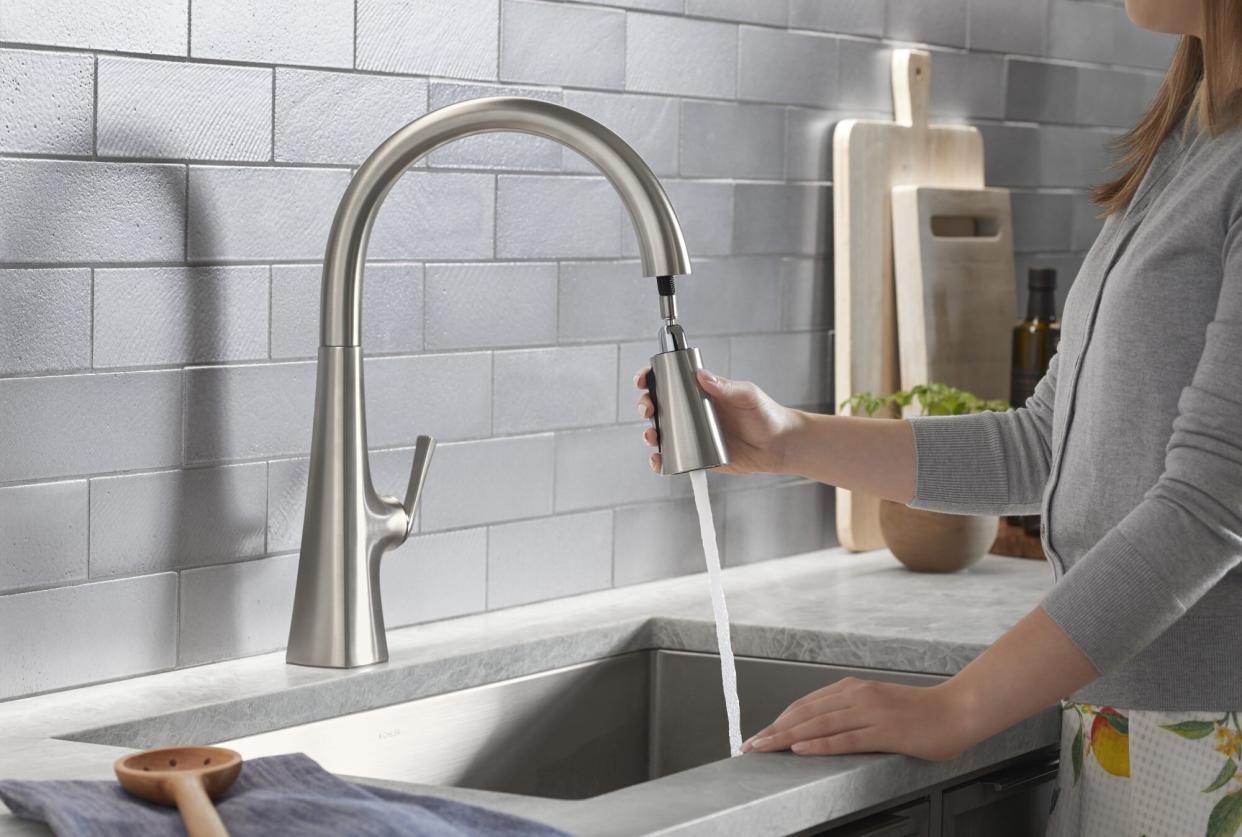This Is Why You Need a Sprayer on Your Kitchen Faucet

Courtesy of Kohler Co.
Who hasn't woken up to a sink filled to the brim with dishes, a messy remnant of last night's lasagna dinner or late-night baking party with your kids? Somehow that pan you left to soak grew into an intimidating stack. It's in these moments, and a thousand more just like them, that a powerful kitchen sprayer can be a lifesaver. Unfamiliar with these kitchen essentials? Here, we'll walk you through exactly why you need a spray head in your kitchen and how to decide which type is right for you, according to experts at two leading brands specializing in kitchen faucets and fixtures.
Related: Our Test Kitchen's Dishwashing Secrets
Task Master Extraordinaire
"Whether you're rinsing down the corners of your sink or cleaning fresh vegetables from the garden, a faucet with the right sprayer helps make quick work of your kitchen tasks," explains Danielle Radic, kitchen product manager at Moen. Sprayers can give more control over the water's stream, improve maneuverability, and help to fill containers faster she explains. One advantage of a sprayer, notes Stephanie Krickeberg, senior product manager kitchen faucets at Kohler, is that it can be pulled around the entire sink, getting at hard to reach spots you might otherwise miss. "Without a sprayer, you're limited to where the faucet releases water," she says.
Kitchen Sink Style
Spray settings include stream or spray options, with a touch-control that lets you toggle between them, plus brands including Moen and Kohler use proprietary technology that dramatically increases the flow rate, a boon for filling large pasta pots and water pitchers faster.
Sprayers fall into three buckets: pull-down, pull-out, and sidespray kitchen faucets. Pull-downs do exactly as their name implies: the pull down from the faucet body, with extended reach and flexibility. They're often taller, with a higher arc than pull-outs. "They're ideal for areas where you may want a taller faucet for a more dramatic look or for easy maneuverability of large pots and pans in and around the sink," says Radic.
Pull-outs have a wand that can be pulled out from the faucet base and work well in tight, vertical spaces. "Integrated spray heads like pull-downs and pull-outs offer the best of both worlds by creating a seamless look while maintaining the functionality of having a sprayer at your fingertips," says Radic. Function, she adds, should always be top of mind.
Sidespray kitchen faucets are stand-alone devices, installed next to the faucet in two-hole sinks. Sometimes it's the best choice for your particular kitchen. "Certain design aesthetics, like a traditional bridge faucet, don't always lend themselves well to a pull-down sprayer," says Krickeberg. "A sidespray can be added to get the same sprays and functionality that would come in a pull-down while maintaining the desired aesthetic."
Weighing Your Options
Sprayer designs range from modern to traditional, and they come in a multitude of colors, materials, and finishes. What's more, they're available in a wide range of prices, from budget-conscious options to luxury investment level. Krickeberg says touchless or smart features lend a heightened level of convenience and cleanliness. Kohler's Crue model, a pull-down spray head with Boost technology ($390, kohler.com), is the brand's least expensive model, while Kallista One, a pull-down faucet with laminar flow, clocks in the highest ($1,750, kohler.com).
When deciding which spray nozzle is right for your kitchen, your kitchen layout and design aesthetic should be top of mind. "Your kitchen faucet should reflect your personal style, so first, choose a design that fits what you're looking for," says Krickeberg. And other factors come into play. "It's important to consider what day-to-day tasks you do in the kitchen, and select a faucet that can enhance your experience in the space and help you complete everyday tasks more efficiently."
If you're a hands-on DIY type, chances are you can install a new faucet yourself by following the manufacturer's installation guide. Not so handy? It might be time to call the plumber.

